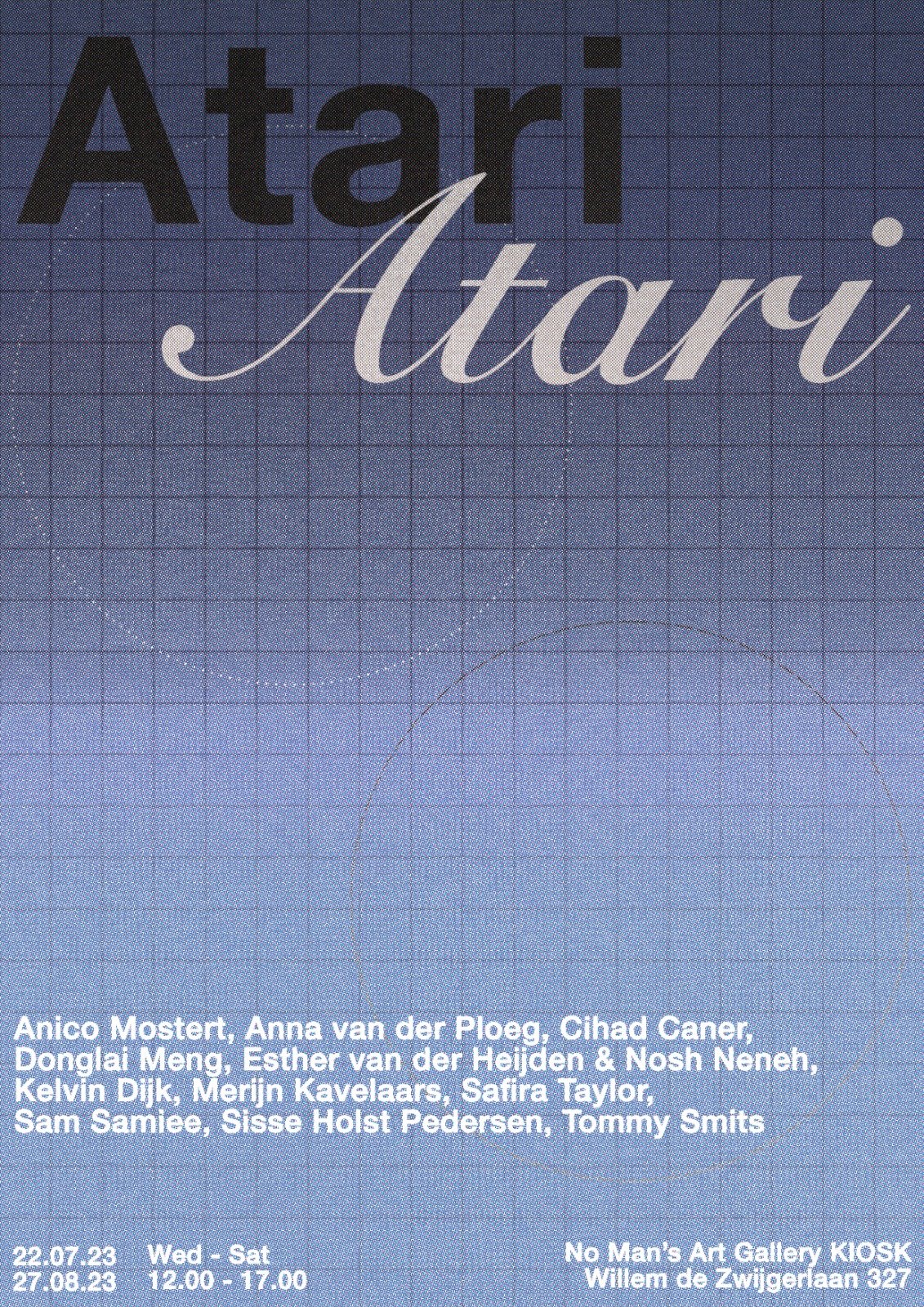Online Catalogue
Anico mostert | Anna van der Ploeg | Cihad Caner | Donglai Meng | Esther van der Heijden & Nosh neneh | kelvin Dijk | Merijn KaVelaars | Safira Taylor | Sam Samiee | Sisse Holst Pedersen | Tommy Smits
Atari
A group exhibition by jiuba art space, hosted at No Man’s Art Gallery
Curated by Sophie Huijbregts
21 July - 27 August 2023
No Man’s Art Gallery is proud to present Atari, a group exhibition that brings together 12 artists whose work inhabits a state of atari: a moment suspended in time, in which the next move must be made. Atari invites us to visit a series of crossroads, touching on topics of interconnectedness and competition, precarity and growth.
In the ancient game of Go, the concept of atari refers to a situation in which a stone is left with only one remaining liberty, or one empty intersection adjacent to the stone. It occurs when a stone’s liberties are reduced to one, caused by the position of the opponent’s stones - meaning the player is faced with the imminent loss of their stone and territory. Therefore, their next move directly and consciously impacts the further path of the game. They can make several strategic decisions, such as defence, counterattack and sacrifice. By recognising atari and responding appropriately, players can either secure their stones' safety or capitalise on their opponent's position to gain an advantage in the game.
Being in a state of atari requires us to hold the weight of all possible paths forward in a single moment: it is a state of contemplation. This is beautifully illustrated in works such as those by Anico Mostert and Donglai Meng. They are meditations, showing us hope and fear and highlighting the multifaceted nature of the human response to risk. At the same time risk can be seen as a catalyst for change, as we can recognise in the works by Sisse Holst Pedersen and Esther van der Heijden. They fuse resilience with fragility, communicating on interconnectedness and growth.
Atari entails the imminent loss or potential gain of territory. This tension evokes a sense of vulnerability, speaking to the role of physical space in the construction of identity and ideas of belonging. In Studies in Cartography, Sam Samiee investigates the power structures at play in the seemingly neutral practice of mapping, drawing attention to the violence underlying this act of capture through imagemaking. It works to render places and peoples legible, defining sets of hierarchies and relationships through which authority can be exerted. If mapping defines territory to impose structures of power, the transgression of those boundaries can be seen as a threat to that same power. Cihad Caner delves further into the construction of the “other” in relation to processes of migration, illustrating how movement through territory puts pressure on ideas of the self. He focuses on water as a driving ecological and political force, as well as a space of flux and uncertainty. Flows of people give rise to anxieties around belonging, their mobility eroding false notions of permanence and stability.
As the moment in which a path must be chosen, atari is also a state of suspension and uncertainty. Kelvin Dijk’s work grapples with the interplay between migration and identity on a personal level, addressing internal feelings of displacement. Through the exploration of (visual) culture and lore, he attempts to connect different localities and create new modes of cultural belonging. A similar act of anchoring oneself in the face of uncertainty can be found in Anna van der Ploeg’s abstractions of Cape Town’s “missing” posters. They are highly localised communications, as an anonymous author sends out a cry for help to those sharing an urban landscape. These strategies can be seen as acts of tracing, of rendering visible networks and connections across space and time. Similarly, Tommy Smits’ works are a testimony to one of many possible paths taken. They embody a series of uncertainties, a chain reaction of decisions made by chance, memorialising each one as fossils in stone.
If the situation at hand is dealt with strategically, atari represents the possibility for gain or growth. Living Monuments of the Deep, a collaborative project between Esther van der Heijden and Nosh Neneh, makes a case for applying such contemplation and awareness to our relationship with the natural world. The works seek to embody the vulnerability of endangered oceanic species, and invite us to cherish the vast interconnectedness of the world we inhabit. In a similar vein, Safira Taylor combines personal histories with fluid interpretations of the vulnerability, growth and interdependence which characterise many organic processes. This cyclical nature can be recognised in Merijn Kavelaar’s 4Flux, which revisits canvasses from past creative processes to fuel new artistic growth.
Atari marks the launch of jiuba art space, a new (online) space for experimentation and play. jiuba is an offshoot of No Man’s Art Gallery, providing a space for spontaneous, joyful and experimental programming on an informal basis with young and emerging artists. As a mostly online space, jiuba will function as an accessible art marketplace that will have occasional physical expressions such as this show.
Atari will be on show from July 22nd until August 27th. The exhibition extends across both gallery locations: No Man’s Art Gallery KIOSK (Willem de Zwijgerlaan 327), open Wednesday through Saturday, 12 - 5pm. No Man’s Art Gallery & de bar (Bos en Lommerweg 88): open daily, 12 - 5pm.
Programme:
Guided tour with curator Sophie Huijbregts and artists
Location: No Man’s Art Gallery KIOSK, Willem de Zwijgerlaan 327
When: Thursday, August 24th
Time: 6 - 10 PM
Photos: Peter Tijhuis





